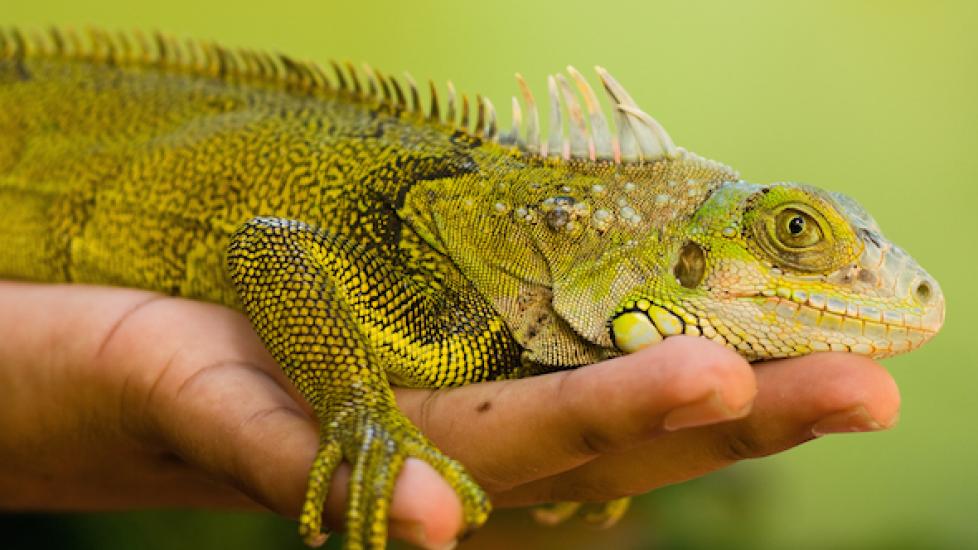How do I Care for My Lizard?
By Cheryl Lock
As far as reptiles go, owning a pet lizard can be a very worthwhile and unique experience, but there are many things to consider before taking one home. “Lizards can be rewarding to keep but they always require more care than snakes, and attention to detail is important,” said Leo Spinner, herpetologist and founder and owner of The Spotted Turtle Herpetological Institute. “A new lizard keeper must be prepared to make the commitment to care for the lizard’s daily needs. It is not advisable for someone to obtain a lizard as a pet when that person has no former pet care experience, or is not responsible enough to manage the lizard’s daily care.”
So, what do those daily needs actually look like? Here are a few things to consider as you consider purchasing a pet lizard.
What do Lizards Eat?
All lizards feed every day, and some species do well on non-living commercial food, while others will require live prey as part of their diet. Some lizards even have specialized diets that may be difficult to acquire. “Horned lizards, for example, mostly eat ants in the wild,” said Mike Wines, Lead Reptile Keeper at the Turtle Back Zoo in New Jersey. “Make sure you have researched your pet’s needs thoroughly and have access to the proper diet for your particular lizard.”
What Should My Lizard’s Habitat Be?
Lizards require a specific amount of space to thrive and it’s important to figure out what yours will need before bringing him home. “Find out what the size of your lizard will be as an adult, and start from there,” Wines said. “Some lizards get very large — like iguanas and several monitor species. These lizards need a lot of space and room to move and they often even need a place to swim.” Some types of lizards can even outgrow their captive environment over time, so the lizard owner will have to be able to keep up with these needs as time goes by, Spinner said. Here are some additional set-up questions to consider:
- Does my lizard need an ultraviolet light? Many advertised products say they provide a good source of ultraviolet light, but in reality they may not put off enough light for your particular lizard. Get a recommendation from your veterinarian for a good product.
- What are the heating requirements for this type of lizard? Some lizards require heating gradients with more than one temperature zone in the tank, as well as hygrometers to measure humidity.
- How does my lizard drink? Will a bowl filled with water suffice or would he prefer a drip system?
- How does this species of lizard deal with the stress of handling? How often should I be playing with him?
While there is no single answer to all of the different requirements and needs your pet will have, thorough research into the species of lizard you’re interested in can help answer many of them. Then, once you have your lizard, avoid common mistakes made by inexperienced lizard keepers, like putting off cleaning a water bowl, removing uneaten food from the tank or forgetting to turn lights in the tank on and off. Your lizard will be his happiest and healthiest when you pay attention to all the details.
Can Lizards Live Together?
Lizard care is very detailed, and because lizards are all so different from each other, it’s not a given that yours will want to share its habitat with another lizard. “Some animals do better in groups, while others do best alone,” Spinner said. Research your particular species ahead of time for details about its personality and ask about your potential pet’s behavior from where you purchase it to get a handle of whether or not you think it will be okay with playmates at all times.
How Should I Interact with My Lizard?
One of the reasons lizards make such great pets is that they tend to be more attentive than other reptiles and respond to their keeper’s behavior and activities. “Lizards tend to be a lot more active than other reptile pets, which makes them a little more interesting in a captive environment,” Spinner said.
Just because lizards make interactive pets, however, doesn’t mean they want (or need) to be handled 24 hours a day, nor should they be left to their own devices all the time, either. “Over or under handling of lizards is a big mistake people tend to make,” said Spinner. “Too much handling can lead to stress and too little can lead to nervous behavior, which ultimately ends with stress.” Your scaly friend will also require regular veterinary visits, as well as mental and physical enrichment to stay healthy and happy. “Research on a pet lizard requires more than just a short conversation with someone at the pet store,” Wines said. “Make sure you can care for the pet for its entire life, and not just when it’s young, small and cute.”
Have a conversation with a veterinarian who specializes in reptiles and/or lizards to help fill in any blanks you may have when it comes to interacting with or caring for your lizards, and make sure you learn about your potential lizard’s diet, size, life span, temperature and humidity requirements and handling requirements before taking it home.
“You should also make sure your lizard is eating before you bring it home,” Wines said. “Look to see if it has injuries like cuts, missing toes or a broken tail, and make sure it is a captive breed. Like snakes, you don’t want a wild-caught lizard. Besides the fact that they are taken from the wild, they often have many parasites that are exacerbated by being in captivity. Some good starter lizards are bearded dragons and leopard geckos. But always do your homework first.”
Image: Michaelpuche / Shutterstock
